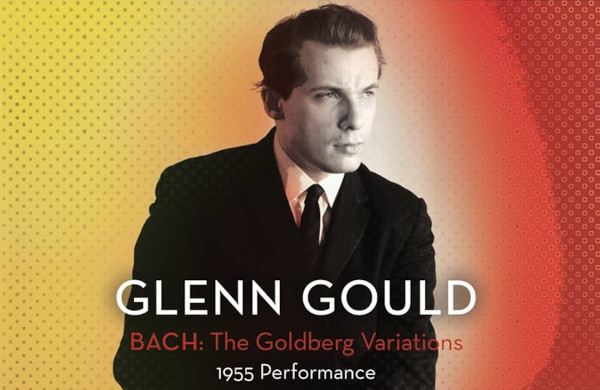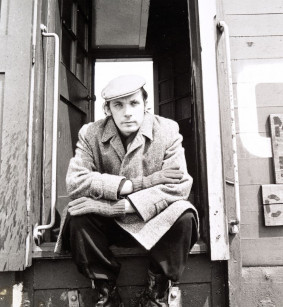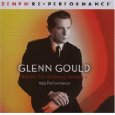ZENPH ARCHAEOLOGY
On September 25, 2006, to standing ovations of members of the Glenn Gould Society in CBC studio in Toronto, Glenn Gould re-performed the Goldberg Variations. He did the same once again in the evening, this time purely for the sake of a recording session. Exciting but not unusual you say, so what was the point? Gould was long after his death at the time.

The best piano music ever recorded?
Glenn Gould, 1955 Goldberg Variations, BWV 988
Zenph Re-performance, Sony Classical SACD 88697 03350 2
Try and mention the Goldberg Variations to a pianist and he or she will probably end up with the name Glenn Gould. The landmark recording of Gouldian Variations (ML 5060) came out from the recording sessions at Columbia Masterworks studios in 1955 and by the end of the decade it established itself as a benchmark for pianists: the sheer virtuosity of Gould and his out-of-this-world technical talent scared away countless piano players and elevated the Variations to godly pantheon of unimitable recordings.
Born in Toronto Glenn Gould is today widely recognized as one of the finest pianists of all time and this status has been actually assigned to him already some fifty years ago. The album that was released the year after the sessions, in 1956, became an international bestseller, unleashed a storm of publicity and made Gould a celebrity. That happened to a young artist at the age of twenty-four!
This was, however, not the last time for Goldberg Variations – Gould returned to the Masterworks studio in 1981 to re-record the pieces digitally at the end of his days and there are also two other live archetypal versions from 1954 (CBC PSCD2007) and 1959 (Sony SRCR-9500).
The live recordings are, unlike other classical artists, quite exceptional for Gould. He preferred the intimacy of a recording studio above all and though he initially performed for audiences in concert hall gradually he developed a kind of disdain for live performances which was summarized in a paper he wrote to „abolish applause and demonstrations of all kinds at concerts“.
After 1964 it was difficult to spot Gould outside of the studio. He was fascinated by endless possibilities of the recording process and got obssessed by the level of control over a recording that was available through sessions and editing. To him, the manipulations with tapes and overdubbing were not the tools of degradation but rather the ways to achieve technical and sonical perfection. As such, Glenn Gould could be considered the first audiophile – but it does not stop here.
 Gould usually played the same instrument, Steinway CD318, sometimes swapping for Yamaha pianos, however sitting always on the same chair. The adjustment of a piano was very precise, he often used wooden blocks and rugs to set the piano at a certain height as the result of his fanatic devotion to every tiny detail. Well, today we would say that it might have helped him to decouple the piano from the floor, like spikes, to get the sound precision he required. However, this was probably not the reason, at least intentionally.
Gould usually played the same instrument, Steinway CD318, sometimes swapping for Yamaha pianos, however sitting always on the same chair. The adjustment of a piano was very precise, he often used wooden blocks and rugs to set the piano at a certain height as the result of his fanatic devotion to every tiny detail. Well, today we would say that it might have helped him to decouple the piano from the floor, like spikes, to get the sound precision he required. However, this was probably not the reason, at least intentionally.
He also was a freak about the environment he played in: the temperature in a recording studio had to be quite high and the same he required for public perfomances. It is said Gould was renowned for peculiar body movements like ´...circular swaying or grasping at the air as if to reach for notes...´and the strangest phenomenon, that had been recorded with his music, was his humming while playing. A listener will not hear the humming while listening to the Zenph Re-performance, however, he/she will hear perfect Gould otherwise.
What happened in September 2006
Zenph Studios focus on building computer sofware to help understand and recreate precisely how a musician performs. The complex algorithms can scan and analyze a recorded piano performance and separates its musical information as pitch and duration of the notes, velocity of key strikes and releases, pedal actions and so on from the non-musical elements like surrounding noise or the aforementioned humming. The next step is to encode the information again into digital data streams that can be fed into a digitally controlled instrument for replay.
Zenph calls the process a re-performance because it is indeed a cloned performance that perfectly copies something that happened dozens years ago. Perfectly means everything, including mistakes that the pianist had made. The whole process is not as easy as it might seem as it requires a lot of hand fine-tuning. Especially with Gould who was famous for his finger tapping technique when he was pulling rather than pushing the piano keys.
For the project Zenph teamed up with ´authentic´personnel. Marc Wienert, Paul Gilchrist, Ted Sambell and Verne Edquist were the men who coordinated and adjusted piano´s timbre to another´s from 50 years earlier under the supervisory of Gould´s former tuner. The renowned recording engineers of Sony Music and CBC joined Steve Epstein of Sony BMG who produced the whole thing and, finally, a technician from Yamaha Artist Service assisted flawless work of the instrument.
For the performance, the carefully processed digital data were converted to hi-def MIDI format and fed into Yamaha Disklavier Pro grand piano which was then miked direct to DSD (Sonoma workstation was used) by a surround array of omnidirectional DPA 4006 microphones. As a test of the recorded re-performance, original and re-performed recordings were played simultaneously on separate channels because, as John Q. Walker of Zenph explains ´the ear detects even a microscopic discrepancy in timing as a disturbing echo´.
On the SACD, apart from the stereo and multichannel mix of the Goldberg Variations you can find another sonic treat: a binaural recording that was created for realistic reproduction through headphones.
The binaural recording was made with the help of a dummy head with two Neumann KU-100 microphones in the place of ears. The head was carefully positioned at the piano bench so that a headphone listener would approximately experience what Glenn Gould might have heard during the performance.
The art and the sound
 Once again, it is important to realize that a listener does not listen to a remastered or digitally treated original but to a real original, i.e. a brand new recording that precisely clones the legendary performance from 1955. Thus the artistry is preserved untouched and the sonics are boosted to the best levels possible.
Once again, it is important to realize that a listener does not listen to a remastered or digitally treated original but to a real original, i.e. a brand new recording that precisely clones the legendary performance from 1955. Thus the artistry is preserved untouched and the sonics are boosted to the best levels possible.
Goldberg Varations are cherished for their both musical and pedagogical values. The individual pieces come with a different level of difficulty depending on the number of voices, complexity of polyphony, hand crossings or tempo. The least difficult exercises helps a player to synchronize and balance his/her hands, the most difficult pieces challenge a player with polyphonic structures. Such polyphonic structures can be found in Variations 10, 18 and 20 that feature three or four voices, often played in a fast tempo – this is what scares away countless pianists: who could ever compete with Gould?
To the same extent the Goldberg Variations are useful to pianists the Zenph re-performance recording is the essential piano album for audiophiles. The sound of the piano is vibrant, rich and harmonious and provides an excellent studying material for the intimate encounter with the concert grand. The acoustics of the CBC studio are more absorptive than usual and the piano is closely miked and that’s where the recording becomes very intimate. What you can hear is more the sound of the strings being struck than the sound reflected from the walls of the studio as the result of the closer than usual perspective – the resonances of the piano’s body and spatial and temporal resolution of individual strings are mesmerizing aural food for any attentive listener. The voicer of the piano, Marc Wienert, says that the Yamaha wins over Steinways with openness and clarity. I have to say that the muted environment of the CBC tamed the clarity a bit – therefore a Steinway would not be (even if it would have been computerized which is not the case) the best option as it is in nature already darker and more saturated in sound. With the Yamaha the perfect balance between the sound of the instrument and the sound of the venue has been reached.
The headphone version is a mind-transforming act: if the stereo and multichannel versions are a kind of ultra-fidelity then the binaural tracks transport you directly to the recording venue and, on top of that, to the body of the artist. Should you have a keyboard in front of you then close your eyes and touch the keys - the illusion is perfect.
There might be a tiny bit of discomfort for classical fans: normally classical performances are played in concert halls as well as they are recorded there and that is why listening to the closely miked piano in the studio is certainly an unusual experience though the beautiful one.
Unfortunately (but maybe fortunately) there is no software available to analyze and re-encode any musical performance so we have to live with Zenph’s piano re-performances (other discs are also available). It is not bad living, however. Standing ovations to Zenph!
Free CC pictures courtesy of https://snl.no/Glenn_Gould



